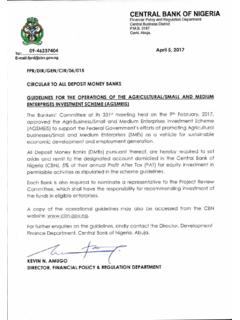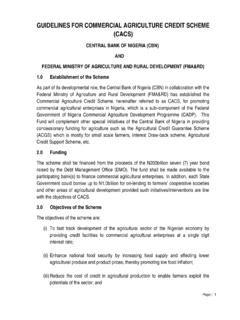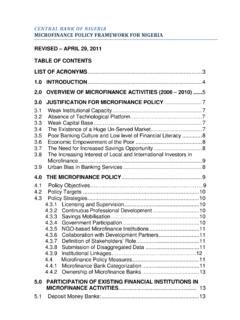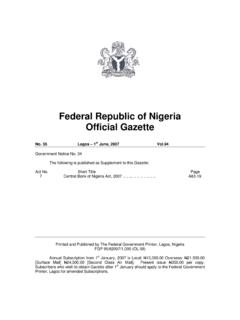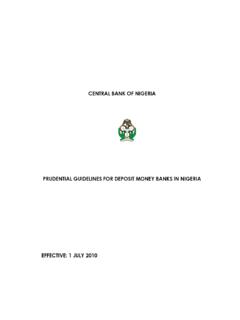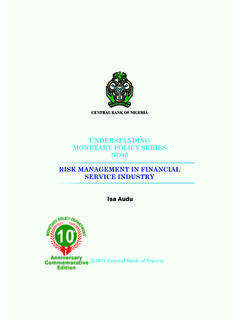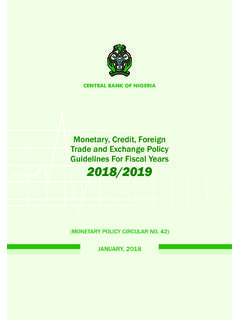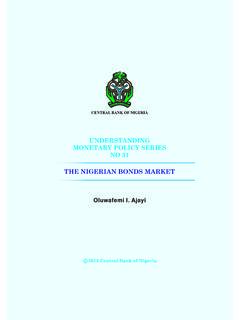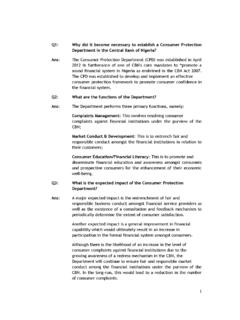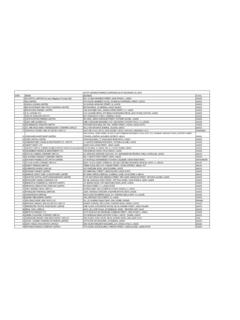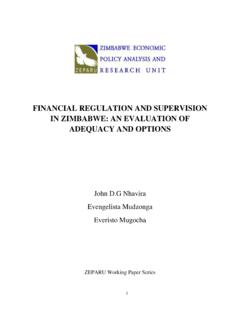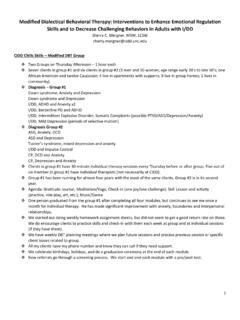Transcription of CENTRAL BANK OF NIGERIA
1 CENTRAL BANK OF NIGERIA GUIDELINES FOR THE regulation and supervision OF MICROFINANCE BANKS IN NIGERIA JANUARY 2020 2 CONTENTS INTRODUCTION .. 5 PERMISSIBLE AND NON-PERMISSIBLE ACTIVITIES .. 6 Permissible Activities .. 6 Non-Permissible Activities .. 7 CATEGORIES OF MICROFINANCE BANKS .. 9 Tier 1 Unit MFB .. 9 Tier 2 Unit MFB .. 9 State Microfinance Bank .. 9 National Microfinance Bank .. 9 OWNERSHIP AND LICENSING REQUIREMENTS .. 10 Ownership Requirements .. 10 Licensing Requirements .. 12 CORPORATE GOVERNANCE .. 19 Basic Requirements .. 19 Organizational Structure .. 20 Certification .. 20 FUNDING, ACCOUNTING AND RELATED MATTERS .. 21 Sources of Funds .. 21 Books of Account .. 21 Rendition of Returns .. 22 OPERATIONAL REQUIREMENTS FOR CBN INTERVENTION FUNDS .. 23 CBN Interventions and Objectives .. 23 Role of MFBs .. 23 Credit Risk .. 23 Single Obligor Limit .. 23 COMPLIANCE WITH MONEY LAUNDERING (PROHIBITION) ACT, 2011, TERRORISM (PREVENTION) ACT, 2011 AND CBN (ANTI-MONEY LAUNDERING AND COMBATTING THE FINANCING OF TERRORISM IN BANKS AND OTHER FINANCIAL INSTITUTIONS IN NIGERIA ) regulations , 2013 AND CIRCULARS.
2 24 COMPLIANCE WITH PROVISIONS OF THE GUDELINES FOR WHISTLE-BLOWING IN THE NIGERIAN BANKING INDUSTRY .. 25 PUBLICATION OF AUDITED FINANCIAL STATEMENTS .. 26 PRUDENTIAL REQUIREMENTS .. 27 COMPLIANCE WITH THE PROVISIONS OF THE RISK-BASED CYBERSECURITY 3 FRAMEWORK AND GUIDELINES FOR OTHER FINANCIAL INSTITUTIONS .. 28 RISK MANAGEMENT .. 29 REQUIREMENTS FOR INCREASE IN SHARE CAPITAL .. 30 DISLOSURE OF REQUIRED INFORMATION TO CREDIT REFERENCE BUREAUX .. 31 OPERATIONAL REQUIRMENTS AND CONTROLS .. 32 APPOINTMENT OF EXTERNAL AUDITOR .. 34 SCHEME OF ARRANGEMENT .. 36 RESTRUCTURING AND RE-ORGANIZATION .. 37 TRANSFORMATION OF NON GOVERNMENTAL ORGANISATION MICROFINANCE INSTITUTIONS (NGO-MFI) .. 39 CONDITIONS FOR REVOCATION OF LICENSE .. 40 EXIT CONDITIONS .. 41 SANCTIONS GRID .. 42 INTERPRETATIONS OF TERMS .. 48 RECOMMENDED MINIMUM OPERATIONAL TEMPLATE FOR MICROFINANCE BANKS IN NIGERIA .. 52 4 These revised guidelines are issued by the CENTRAL Bank of NIGERIA [hereinafter referred to as the CBN or the Bank ] in exercise of the powers conferred on it by the CENTRAL Bank of NIGERIA Act CAP C4 LFN 2010 and the Banks and Other Financial Institutions Act CAP B3 LFN 2010 [hereinafter referred to as BOFIA ].
3 5 INTRODUCTION The Microfinance Policy, Regulatory and Supervisory Framework was issued December 15, 2005 and revised in 2011 to, among others, increase financial inclusion rate in the country, improve access to financial services for the economically active poor, pursue poverty eradication as well as mainstream the informal microfinance sub-sector into the formal financial system. The policy established microfinance banks as the crucial vehicle for the attainment of these goals. Microfinance banks were expected to provide access to financial services such as micro-savings, micro-credits, transfer services and other financial products targeted at the economically active poor. These services have, over time, evolved to include the transmission of government s developmental initiatives. The CBN, in 2013, issued the Revised Regulatory and Supervisory Guidelines for Microfinance Banks in NIGERIA , to address challenges observed in the implementation of the Microfinance Policy of 2005 and emerging developments in the industry.
4 The Guidelines sought to promote rapid and sustainable growth of the microfinance industry, leveraging on global best practice in microfinance banking. The current review seeks to engender strong and financially sustainable microfinance banks, enhance the safety and soundness of the microfinance sub-sector. The Guidelines shall be read in conjunction with the provisions of the CBN Act, the BOFIA, other subsidiary legislations made under the Acts, as well as written directives, notices, circulars, frameworks and other guidelines that the CBN and other regulators in the financial services sector have issued or may issue from time to time. The Guideline covers categories of microfinance banks, ownership and licensing requirements, permissible and prohibited activities, funding, corporate governance, prudential and anti-money laundering requirements, amongst others. 6 PERMISSIBLE AND NON-PERMISSIBLE ACTIVITIES Permissible Activities An MFB shall be allowed to engage in the provision of the following services to its clients: a.
5 Acceptance of various types of deposits including savings, time, target and demand deposits from individuals, groups and associations; b. Provision of credit to its customers; c. Provision of housing micro loans; d. Provision of ancillary services such as capacity building on record keeping and small business management and safe custody ; e. Issuance of debentures to interested parties to raise funds from members of the public with the prior approval of the CBN; f. Collection of money or proceeds of banking instruments on behalf of its customers including clearing of cheques through correspondent banks; g. Act as agent for the provision of mobile banking, micro insurance and any other services as may be determined by the CBN from time to time, within the geographic coverage of its licence; h. Appoint agents to provide financial services on its behalf in line with the CBN Agent Banking Guidelines, within the geographic coverage of its licence; i.
6 Provision of payment services such as salary, gratuity, pension for employees of the various tiers of government; j. Provision of loan disbursement services for the delivery of the credit programme of government, agencies, groups and individual for poverty alleviation on non-recourse basis; k. Provision of banking services to its customers such as domestic remittance of funds; l. Maintenance and operation of various types of account with other banks in NIGERIA ; m. Investment of its surplus funds in suitable money market instruments approved by the CBN; 7 n. Operation of micro leasing facilities, microfinance related hire purchase and arrangement of consortium lending; o. Participate in CBN Intervention Fund and funds other sources; p. Provision of microfinance related guarantees for its customers; q. Financing agricultural inputs, livestock, machinery and industrial raw materials to low- income persons; r. Investment in cottage industries and income generating projects for low-income persons as may be prescribed by the CBN from time to time; s.
7 Provision of professional advice to low-income persons regarding investments in small businesses; t. Issuance of domestic commercial paper subject to the approval of the CBN; u. Provide financial and technical assistance and training to microenterprises; and v. Any other permissible activity as may be approved by the CBN from time to time Non-Permissible Activities MFBs shall not engage in the provision of the following financial services: a. Foreign currency transactions, except foreign currency borrowings; b. International commercial papers; c. International corporate finance; d. International electronic funds transfer; e. Clearing house activities; f. Collection of third party cheques and other instruments for the purpose of clearing through correspondent banks; g. Dealing in land for speculative purposes; h. Dealing in real estate except for its use as office accommodation; i. Provision of any facility for speculative purposes; 8 j.
8 Leasing, renting, and sale/purchase of assets of any kind with related parties and/or significant shareholders (five per cent or more of the equity) of the MFB, without the prior written approval of the CBN; k. Financing of any illegal activities; and l. any activity other than those permitted as stated above or as may be prescribed by the CENTRAL Bank of NIGERIA from time to time 9 CATEGORIES OF MICROFINANCE BANKS There shall be four (4) categories of MFBs: Tier 1 Unit MFB A Unit Microfinance Bank with urban authorization (Tier 1) shall operate in the banked and high-density areas, and is allowed to open not more than four (4) branches outside the head office within five (5) contiguous Local Governments Areas, subject to the approval of the CBN. Tier 2 Unit MFB A Unit Microfinance Bank with rural authorization (Tier 2) shall operate only in the rural, unbanked or underbanked areas, and is allowed to open one branch outside the head office within the same Local Government Area subject to the approval of the CBN.
9 State Microfinance Bank A State Microfinance Bank is authorized to operate in one State or the Federal Capital Territory (FCT). It is allowed to open branches within the same State or the FCT, subject to prior written approval of the CBN for each new branch or cash centre. It shall not be permitted to open more than two branches in the same Local Government Area (LGA) unless it has established at least one branch or cash centre in every LGA of the State. A newly licensed State MFB shall not commence operations with more than ten (10) branches. National Microfinance Bank A National Microfinance Bank is authorized to operate in more than one State including the FCT. A newly licensed National MFB shall not commence operations with more than ten (10) branches. 10 OWNERSHIP AND LICENSING REQUIREMENTS Ownership Requirements A microfinance bank may be established by individuals, group of individuals, community development associations, private corporate entities and foreign investors subject to a maximum of 49% shareholding for individuals and aggregate related parties.
10 No individual, group of individuals, their proxies or corporate entities and/or their subsidiaries shall own controlling interest in more than one MFB, except as approved by the CBN. A financial holding company that intends to set up any category of MFB as subsidiary shall be required to meet the prescribed capital and other requirements stipulated in these Guidelines. Government s participation in the establishment of microfinance banks shall be structured according to the following models: A. Fully Owned Government Microfinance Bank Model In this model, the State or Local Government is allowed 100 per cent ownership of the equity of a MFB but shall progressively divest its interest to private investors within a maximum period of five (5) years. Two variants of the model are envisaged as follows: (i) Government Fully Owned State Microfinance Bank: A state or local government is allowed to establish a state microfinance bank, which may, subject to prior approval of the CBN, be allowed to have branches within the local government areas in the state to reach its target market.
